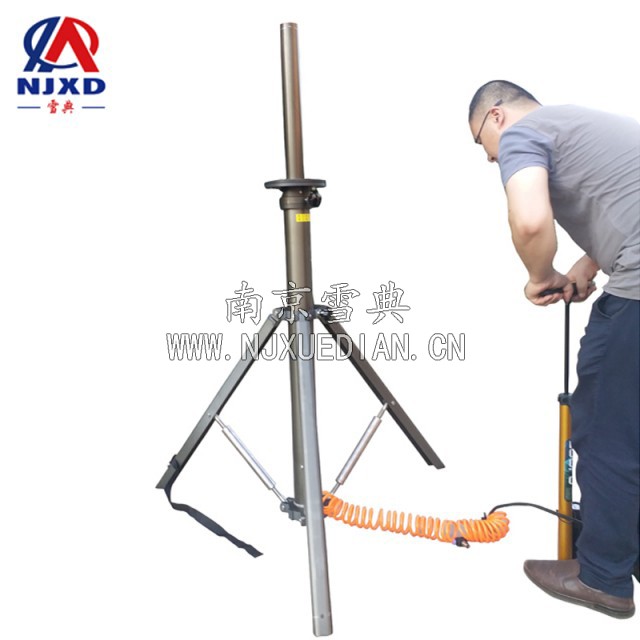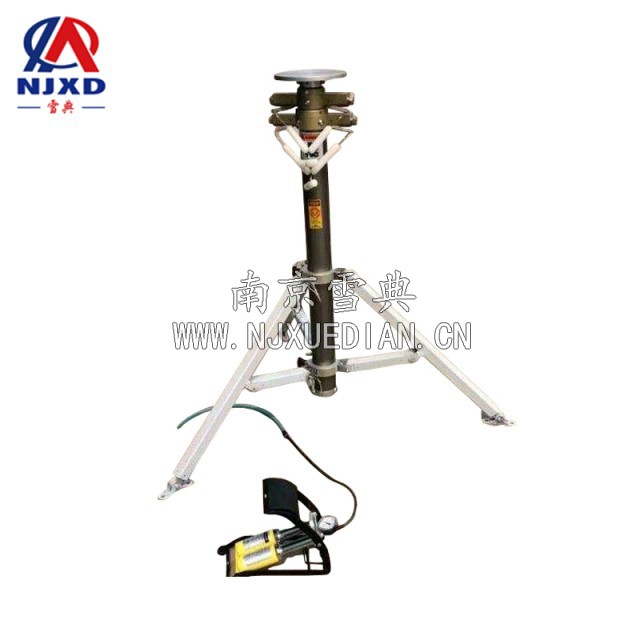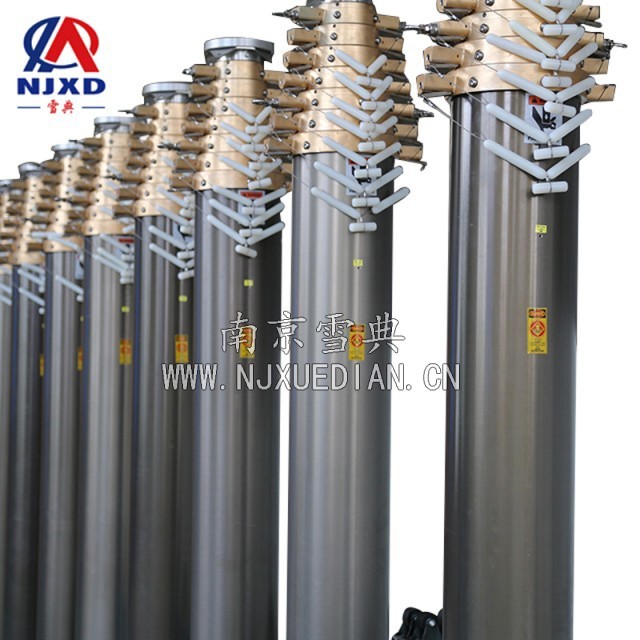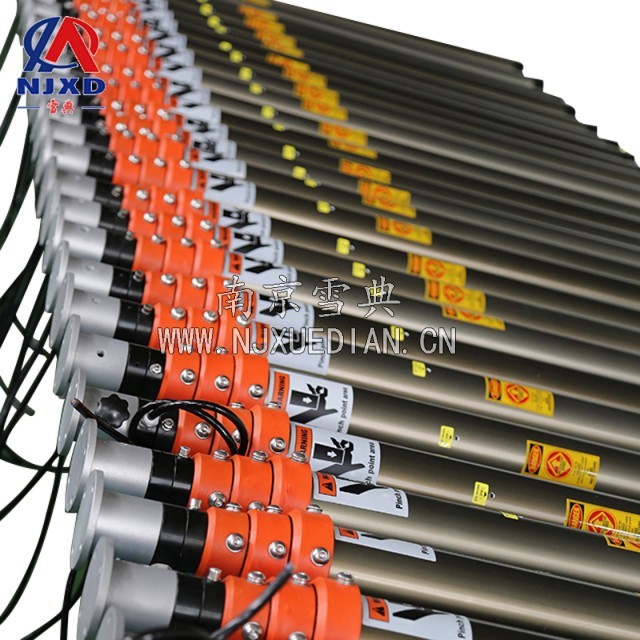NEWS
Basic knowledge of pneumatic lifting rod sealing technology
Time:2021-09-15 View:

Sealing is to prevent fluid or solid particles from leakage between adjacent joint surfaces and to prevent external impurities (such as dust and moisture, etc.) from invading the internal parts or measures of the machine and equipment. Technology is the continuous development of social productivity in the continuous development of production tools, equipment, equipment, language, digital data, information records, etc. from low level to high level, called technology. Sealing technology is in the continuous development of social productivity, in order to prevent fluid or solid particles from leaking between adjacent joint surfaces, and to prevent external impurities (such as dust and moisture, etc.) the increasing level of components or measures that invade the interior of machinery and equipment. It can be used in telescopic mast.

Basic knowledge
1.1 leak
Leakage is one of the faults that often occur in mechanical equipment. There are two main reasons for the leakage: One is that due to the result of machining, the surface of mechanical products must have various defects and shape and size deviations. Therefore, the gap will inevitably be generated at the joint of mechanical parts; The second is that there is a pressure difference on both sides of the seal, and the working medium will leak through the gap.
Reducing or eliminating gaps is the main way to prevent leakage. The function of sealing is to seal the gap between the joint surfaces, isolate or cut off the leakage channel, increase the resistance in the leakage channel, or add a small work element in the Channel to cause pressure on the leak, partially counteract or fully balance with the pressure difference that causes the leak to stop the leak.
For the sealing of the vacuum system, in addition to the above sealing media directly through the sealing surface leakage, but also consider the following two types of leakage:
Leakage. That is, under the action of the pressure difference, the leakage of the sealed medium through the capillary of the seal material is called leakage;
The spread. That is, under the action of the concentration difference, the sealed medium passes through the sealing gap or the material produced by the capillary of the sealing material to become diffusion.
1.2 The classification
Sealing can be divided into two categories: the static seal between the relatively stationary joint surface and the dynamic seal between the relatively moving joint surface. Static sealing is mainly a little sealing, glue sealing and contact sealing three categories. According to the working pressure, the static seal can be divided into medium and low pressure static seal and high pressure static seal. Medium and low pressure static seals are commonly used in soft materials and wider gasket seals, while high pressure static seals use hard materials and narrow Contact width of metal gaskets. Dynamic seal can be divided into two basic types: Rotary seal and reciprocating seal. According to whether the seal is in contact with the relative movement of the parts, it can be divided into contact seal and non-contact seal. Generally speaking, the sealing performance of the contact seal is good, but it is limited by friction and wear, and it is suitable for occasions with low linear velocity of the sealing surface. The non-contact seal has poor sealing performance and is suitable for higher speed occasions.
1.3 sealing the selection
The basic requirements for sealing are good sealing, safety and reliability, long life, and should strive for compact structure, simple system, convenient manufacturing and maintenance, and low cost. Most seals are vulnerable parts, which should ensure interchangeability, achieve standardization and serialization.

1.4 sealing material
1.4.1 Types and uses of sealing materials
The sealing material shall meet the requirements of the sealing function. Due to the different media being sealed and the different working conditions of the equipment, the sealing material is required to have different adaptability. The requirements for sealing materials are generally:
1) The material has good compactness and is not easy to leak the medium;
2) Have appropriate mechanical strength and hardness;
3) Good compressibility and resilience, small permanent deformation;
4) No softening, no decomposition at high temperature, no hardening at low temperature, no brittle crack;
5) Good corrosion resistance, long-term work in acid, alkali, oil and other media, its volume and hardness changes little, and does not stick to the metal surface;
6) Small friction coefficient and good wear resistance;
7) It has the flexibility to be combined with the sealing surface;
8) Good aging resistance and durability;
9) The processing and manufacturing are convenient, the price is cheap, and the materials are easy to obtain.
Rubber is the most commonly used sealing material. In addition to rubber, suitable for sealing materials include graphite, PTFE and various sealants.
1.4.2 General rubber sealing product materials
General-purpose rubber sealing products are more and more widely used in national defense, chemical, coal, petroleum, metallurgy, transportation and machinery manufacturing industries, and have become the basic parts and accessories in various industries.
Common materials for rubber sealing products are as follows.
1.4.2.1 nitrile rubber
Nitrile rubber has excellent resistance to fuel oil and aromatic solvents, but it is not resistant to Ketones, Esters and hydrogen chloride and other media, so oil-resistant sealing products and the use of nitrile rubber.
1.4.2.2 neoprene
Neoprene rubber has good oil and solvent resistance. It has good resistance to gear oil and transformer oil, but not resistant to aromatic oil. Neoprene also has excellent weather aging and ozone aging properties. The crosslinking fracture temperature of neoprene rubber is above 200 ℃, and neoprene rubber is usually used to make door and window sealing strips. Neoprene rubber also has good corrosion resistance to inorganic acids. In addition, because neoprene also has good flexibility and breathability, can be made into diaphragm and vacuum sealing products.
1.4.2.3 natural rubber
Compared with most synthetic rubbers, natural rubber has good comprehensive mechanical properties, cold resistance, high resilience and wear resistance. Natural rubber is not resistant to mineral oil, but is more stable in vegetable oils and alcohols. The Rubber Bowl is used as a seal in the hydraulic brake system of a brake fluid composed of n-butanol and refined castor oil. The rubber rings are made of natural rubber, and general sealants are also commonly used in natural rubber.
1.4.2.4 fluorine rubber
Fluorine rubber has outstanding heat resistance (200~250 ℃), oil resistance, can be used to manufacture cylinder liner sealing ring, Rubber Bowl and rotating lip sealing ring, can significantly improve the use of time.
1.4.2.5 silicone rubber
Silicone rubber has outstanding high and low temperature resistance, ozone resistance and weather aging performance, in-70~260 ℃ working temperature range can maintain its unique use of elasticity and ozone resistance, weather resistance and other advantages, suitable for the production of sealing gaskets required in the thermal mechanism, such as strong light source lampshade sealing lining, valve gasket, etc. Because silicone rubber is not oil-resistant, low in mechanical strength and expensive, it is not suitable to make oil-resistant sealing products.
1.4.2.6 ethylene-propylene-Diene Rubber
The main chain of EPDM rubber is a completely saturated straight chain structure without double bonds, and its side chain has Diene, so it can be vulcanized with sulfur. EPDM rubber has excellent aging resistance, ozone resistance, weather resistance, heat resistance (can be used at 120 ℃ for a long time), chemical resistance (such as alcohol, acid, strong alkali, oxidant), but not resistant to aliphatic and aromatic solvents. EPDM rubber has the lowest density in rubber with high filling characteristics, but lacks self-adhesion and mutual viscosity. In addition, EPDM rubber has outstanding steam resistance, can make steam resistant diaphragm and other sealing products. EPDM has been widely used in washing machines, accessories and door and window sealing products in washing machines, TV sets, or a variety of composite profiles of rubber strips.
1.4.2.7 polyurethane rubber
Polyurethane rubber has excellent grinding and good impermeability, the use temperature range is generally-20~80 ℃. In addition, it also has Medium Oil resistance, oxygen resistance and ozone aging resistance, but it is not resistant to acid and alkali, water, steam and ketones. Suitable for manufacturing various rubber sealing products, such as oil seals, O-rings and diaphragms.
1.4.2.8 epichlorohydrin rubber
Chlorine ether rubber has the advantages of nitrile rubber, neoprene rubber, and acrylate rubber. Its oil resistance, heat resistance, ozone resistance, flame resistance, alkali resistance, water resistance and organic solvent resistance are very good, and has good process performance, its cold resistance is poor. When the use temperature is not too low, chloroether rubber is still a good material for sealing products such as oil seals, various sealing rings, gaskets, diaphragms and dust covers.
1.4.2.9 acrylate rubber
Acrylate rubber has heat-resistant oil (mineral oil, lubricating oil and fuel oil), especially at high temperature oil stability, generally up to 175°C, gap use or short time can withstand temperature 200°C. Its disadvantage is poor cold resistance. Therefore, it is suitable for making oil seals with high temperature resistant oil in non-cold areas, but it is not suitable for sealing products under tensile or compressive stress at high temperatures.

The main characteristics, working temperature, main use of different rubber species
Nitrile rubber
Oil resistance, heat resistance and good wear resistance. Widely used in the manufacture of sealing products, but not suitable for phosphate series hydraulic and gear oils containing polar additives.
-40~120 ℃
Used to make "O" rings, oil seals, suitable for general hydraulic and pneumatic systems.
Hydrogenated Nitrile Rubber (HNBR)
High strength, oil resistance, wear resistance, heat resistance and aging resistance.
-40~150 ℃
Used for high temperature, high speed reciprocating seal and rotary seal.
xiang su jiao
The material has large elastic modulus, high strength, and other properties are the same as above.
-30~80 ℃
Used to make "O" ring, "Y" ring, dust ring, etc., applied to the sealing of construction machinery and high-pressure hydraulic system.
Fluorine rubber
Heat resistance, acid and alkali resistance and other chemicals, oil resistance (including phosphate series hydraulic oil), suitable for all lubricating oil, gasoline, hydraulic oil, synthetic oil.
-20~200 ℃
It is suitable for sealing high temperature resistance, chemicals and flame resistant hydraulic oil, and is widely used in metallurgy, electric power and other industries.
Polyurethane
Excellent wear resistance, high strength and good aging resistance.
-20~80 ℃
Suitable for high-pressure and high-speed system sealing in construction machinery and metallurgical equipment.
Silicone rubber
Good heat and cold resistance. Small compression set, but low mechanical strength
-60~230 ℃
Suitable for high and low temperature high-speed rotating seals and food machinery sealing.
Polyacrylate
Heat resistance is better than NBR, can be used in various lubricating oil, hydraulic oil, petroleum hydraulic oil containing polar additives, water resistance is poor.
-20~150 ℃
It can be used for various car oil seals and various gearboxes and gearboxes, which can withstand medium and high temperatures.
Ethylene-propylene rubber
Good climate resistance, aging resistance in the air, General oil resistance, resistance to Freon and a variety of refrigerants.
-50~150 ℃
Used in the sealing of refrigerators and refrigeration machinery.
Polytetrafluoroethylene
Good chemical stability, good heat resistance, cold resistance, oil, water, steam, medicine and other media. High mechanical strength, high temperature resistance, wear resistance, extremely low friction coefficient, good self-lubrication.
-55~260 ℃
The production of wear-resistant rings, guide rings, retaining rings are commonly used in machinery, widely used in metallurgy, petrochemical, construction machinery, light industrial machinery.
Nylon
Oil resistance, heat resistance, good wear resistance, high compressive strength, good impact resistance, but poor dimensional stability.
-40~120 ℃
Used to make Guide ring, support ring, pressure ring, retaining ring.
Polyoxymethylene (POM)
Oil resistance, heat resistance, good wear resistance, high compressive strength, good impact resistance, good self-lubricating performance, good dimensional stability, but poor flexibility.
-40~140 ℃
Used to make guide rings and retaining rings.

CATEGORY
NEWS
- Influencing Factors and development process of stainless steel lift rod materials
- Basic knowledge of pneumatic lifting rod sealing technology
- Circular section lift rod adopts feather key to prevent rotation
- Lift rod development direction of sealing technology
- Composition and principle of mechanical seal overview pneumatic lifting bracket